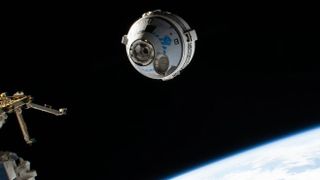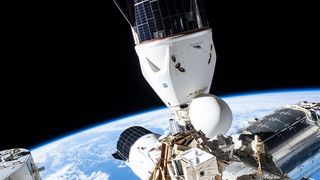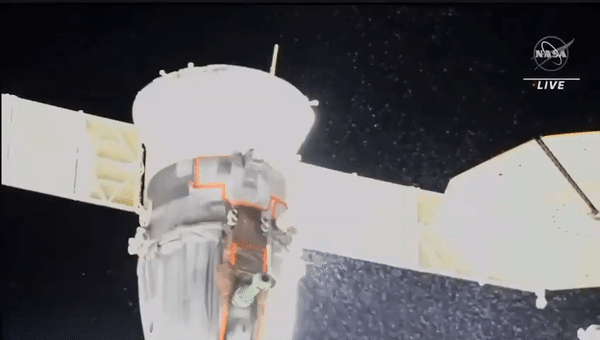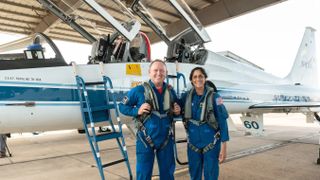2 astronaut taxis: Why NASA wants both Boeing's Starliner and SpaceX's Dragon
Having two crew-carrying spacecraft provides redundancy for NASA and the nation.

HOUSTON — The United States' second private crew-carrying spacecraft is finally ready to bear astronauts.
NASA and Boeing teams recently cleared for liftoff the Crew Flight Test (CFT) of Boeing's Starliner, which is set to launch on May 6. Starliner will be the second spacecraft funded by the agency's commercial crew program to carry astronauts, following SpaceX's Crew Dragon, which made its crewed debut in May 2020.
"We are really excited to have this second transportation system up and available to us," Steve Stich, program manager for NASA's Commercial Crew Program, said in a press conference here at the agency's Johnson Space Center on March 22.
Stich emphasized that the program had wanted, all along, two very different spacecraft with different procedures and teams to support them, to have a backup in case one ship is sidelined due to a safety or other issue. "We've seen in the past the importance, I think, of having this dissimilar redundancy, [because] it's always tough to fly into space," he said.
Related: 1st Boeing Starliner astronauts are ready to launch to the ISS for NASA (exclusive)
CFT will bear two NASA veteran astronauts and former Navy test pilots into space, Butch Wilmore and Suni Williams. They will shake down the spacecraft during a "developmental" mission, meaning that a few changes may happen to procedures, teamwork or the spacecraft following "lessons learned" from this flight. Assuming all goes well, Starliner will then be certified for six-month missions to the ISS next year.
SpaceX and Boeing both received contracts from NASA in 2014 to ferry astronauts to and from the International Space Station (ISS), with SpaceX receiving a contract valued at $2.6 billion and Boeing one at $4.2 billion. SpaceX began running its operational missions in 2020 and has sent 11 such crews to the ISS so far (eight for NASA and three for Axiom Space, a private company that organizes short-term stays on the complex.)
Get the Space.com Newsletter
Breaking space news, the latest updates on rocket launches, skywatching events and more!
Starliner has flown two uncrewed missions in space. The capsule's astronaut debut has been delayed multiple times due to technical issues, most of them experienced during its first test flight in 2019, which failed to meet up with the ISS as planned. Starliner's second test flight to the orbiting lab, in May 2022, met all of its major objectives. Further delays arose more recently, due to issues with Starliner's parachute system and the fact that much of its wiring was wrapped in flammable tape.
During press activities here in Houston, Boeing, NASA and the astronauts emphasized repeatedly that those earlier problems have all been addressed. Should CFT go as planned and all schedules hold, Boeing will launched the operational crewed mission Starliner-1 to the ISS for a six-month stay in early 2025, with more flights to follow.
Related: Boeing begins fueling Starliner capsule ahead of 1st astronaut launch

Despite the Starliner delays, the U.S. is about to have two private crew-carrying spaceraft at its disposal, which will provide ISS backup in many forms. Dana Weigel, then deputy program manager for the ISS, pointed out in the March 22 press conference that one of the program's goals is to keep the station continuously crewed. The station's life support systems assume "constant throughput" from humans, among other items, and the astronauts do preventative maintenance on the complex as well.
"When we talk about having multiple providers, [that's] why it's so important for us to have that continual capability," added Weigel, who was promoted to program manager for the ISS on April 7.

Incidentally, these are not the only crewed spacecraft flying to and from the ISS; Russia's Soyuz spacecraft has been doing so ever since the complex joined its first two modules in 1998. Soyuz and NASA's space shuttle used to trade off astronaut missions back in the day; the shuttle retired in 2011.
Soyuz had to go it alone for nearly a decade after the space shuttle retired, but that's far from ideal; NASA wants backup for safety and policy reasons. For example, a Soyuz spacecraft in 2022 sprung a coolant leak that essentially forced Russia to ship a new Soyuz vehicle to space as rapidly as possible for the three astronauts needing a ride home.
In the meantime, mission managers squeezed an extra seat on board a docked SpaceX Dragon, in case there was trouble on the ISS that forced evacuation,. (Russian tests suggested the remaining two astronauts manifested on Soyuz could safely fly home on the coolant-less spacecraft.) That backup was not necessary, but all the additional spacecraft changes forced the Soyuz astronauts to double their stay to a year, while awaiting their relief crew.
Related: How many astronauts can fly on a SpaceX Crew Dragon capsule?

Weigel specifically pointed to this leak situation as "a great example where ... we were able to leverage contingency capability, in this case with Crew Dragon."
While SpaceX is highly reliable, backups are always appreciated; Weigel noted that all Dragons fly on a single rocket, the Falcon 9 or F9, which is also used to launch SpaceX Starlink satellites and other missions.
"If there was a problem with F9, for example — and we had to stand down for a while to understand the problem — if we had another vehicle, we could continue flying," she said.

This all assumes, of course, that Starliner passes all of its testing. Mark Nappi, vice president and program manager of Boeing's commercial crew program, outlined for reporters several key milestones the company is tracking.
Boeing wants to make sure the CFT astronauts are comfortable and can work with all the equipment at all phases of the mission, which means key systems like life support need to work properly. Thruster performance will be evaluated during dynamic events — like ISS approach, rendezvous and docking — along with the manual and auto navigation systems. Starliner will also need to perform well during its approximate week at the ISS, when it goes into "quiescent" mode to save on energy.
"Then we'll undock," Nappi continued. "We'll confirm our manual piloting system; we'll be able to go into the backup mode and let Butch and Suni use the hand controllers to make sure it acts as expected." From there, he continued, Starliner will be evaluated on its performance during reentry and landing, including aspects such as its heat shield, parachute and human recovery operations.
Stich pointed to another benefit of commercial crew: allowing each of the contractors (Boeing and SpaceX) to choose how they want to operate as long as all certification and safety requirements are met.
SpaceX, for example, has all of its mission control operations at its headquarters in Hawthorne, California. Boeing chose to split its teams between JSC and a mission control center in Florida. Because Boeing is co-located with NASA employees here at JSC, Stich emphasized, there is an advantage.
"It's allowed NASA to keep some of those critical flight operations skills, training the crews and then operating the vehicle for launch and landing phases in those critical phases of flight," Stich said. That experience will be useful for cross-training, he said, as NASA prepares to certify its Lockheed Martin-led Orion spacecraft for moon missions as soon as 2025, with Artemis 2.
Join our Space Forums to keep talking space on the latest missions, night sky and more! And if you have a news tip, correction or comment, let us know at: community@space.com.

Elizabeth Howell (she/her), Ph.D., is a staff writer in the spaceflight channel since 2022 covering diversity, education and gaming as well. She was contributing writer for Space.com for 10 years before joining full-time. Elizabeth's reporting includes multiple exclusives with the White House and Office of the Vice-President of the United States, an exclusive conversation with aspiring space tourist (and NSYNC bassist) Lance Bass, speaking several times with the International Space Station, witnessing five human spaceflight launches on two continents, flying parabolic, working inside a spacesuit, and participating in a simulated Mars mission. Her latest book, "Why Am I Taller?", is co-written with astronaut Dave Williams. Elizabeth holds a Ph.D. and M.Sc. in Space Studies from the University of North Dakota, a Bachelor of Journalism from Canada's Carleton University and a Bachelor of History from Canada's Athabasca University. Elizabeth is also a post-secondary instructor in communications and science at several institutions since 2015; her experience includes developing and teaching an astronomy course at Canada's Algonquin College (with Indigenous content as well) to more than 1,000 students since 2020. Elizabeth first got interested in space after watching the movie Apollo 13 in 1996, and still wants to be an astronaut someday. Mastodon: https://qoto.org/@howellspace
-
Unclear Engineer Strange that this article did not mention that Starliner will land on land, rather than "splash down" on a body of water. That is something the Russians have been doing all along, but is a first for the U.S. and has some advantages.Reply
But, it seems really sad that Boeing got a contract for 62% more money than SpaceX, and at the same time, yet is more than 2 years behind SpaceX in delivering a working system.
I understand the desire for redundancy, especially after the Space Shuttle Program's disastrous ending. But, given Boeing's other problems with commercial airliners, it still remains to be seen how much additional reliability is attained from the Boeing system.
With other commercial players like Dream Chaser, New Glen, etc. etc., there may soon be a lot more alternatives to chose from. -
fj.torres Reply
Two systems is good.Unclear Engineer said:Strange that this article did not mention that Starliner will land on land, rather than "splash down" on a body of water. That is something the Russians have been doing all along, but is a first for the U.S. and has some advantages.
But, it seems really sad that Boeing got a contract for 62% more money than SpaceX, and at the same time, yet is more than 2 years behind SpaceX in delivering a working system.
I understand the desire for redundancy, especially after the Space Shuttle Program's disastrous ending. But, given Boeing's other problems with commercial airliners, it still remains to be seen how much additional reliability is attained from the Boeing system.
With other commercial players like Dream Chaser, New Glen, etc. etc., there may soon be a lot more alternatives to chose from.
Two systems with different tech is better.
Anything but old space boeing would be best.
They should've gone with SpaceX and Sierra. -
Unclear Engineer Reply
I think that is where we will end-up, anyway.fj.torres said:They should've gone with SpaceX and Sierra. -
Cisventure Astronot Reply
New Glen is a launch vehicle. Dream Chaser, Starship, and Orion are the only other American orbital crew capsules in development that I know of. I don't think Starship will be crew-rated anytime soon (If ever), and Orion might be used exclusively for the Artemis program. I'm excited for Dream Chaser, though.Unclear Engineer said:With other commercial players like Dream Chaser, New Glen, etc. etc., there may soon be a lot more alternatives to chose from. -
24launch Not only did Boeing get 62% more than SpaceX, they got an additional $287.2 million in 2019 from NASA when they considered cutting their losses. That brings their total to $5.1 Billion vs SpaceX's $3.1 Billion.Reply
AND on top of all that they're charging nearly 2x per seat than SpaceX - $90 million vs $55 million. Even more than Roscosmos was charging at $80 million. Boeing's snarky justification for the higher cost (they would only compare to Roscosmos) was that domestic launches cost more. Much of that too is the higher cost of the Atlas V. This is why they'll never do commercial launches. Who would pay nearly double per seat? They only ever plan to have 2 capsules and in order to fly on rockets other than the Atlas V someone has to pay for that certification.
There's a good Eric Berger article from 2022 that analyzes the costs over the 6 required missions of the initial contract.
The problem everyone points out with DreamChaser is there is no crewed version (sure, yet) and because it launches INSIDE the payload fairing there's no crew abort available during launch.
Starship will of course be crew certified eventually though it's overkill for the ISS. The Falcon 9 is a now extremely reliable launch vehicle and with continued increases in reusability (2 launched 20 times so now they're targeting 40) they're not going to "discontinue" it anytime soon. -
Cisventure Astronot Reply24launch said:Not only did Boeing get 62% more than SpaceX, they got an additional $287.2 million in 2019 from NASA when they considered cutting their losses. That brings their total to $5.1 Billion vs SpaceX's $3.1 Billion.
AND on top of all that they're charging nearly 2x per seat than SpaceX - $90 million vs $55 million. Even more than Roscosmos was charging at $80 million. Boeing's snarky justification for the higher cost (they would only compare to Roscosmos) was that domestic launches cost more. Much of that too is the higher cost of the Atlas V. This is why they'll never do commercial launches. Who would pay nearly double per seat? They only ever plan to have 2 capsules and in order to fly on rockets other than the Atlas V someone has to pay for that certification.
There's a good Eric Berger article from 2022 that analyzes the costs over the 6 required missions of the initial contract.
The problem everyone points out with DreamChaser is there is no crewed version (sure, yet) and because it launches INSIDE the payload fairing there's no crew abort available during launch.
Starship will of course be crew certified eventually though it's overkill for the ISS. The Falcon 9 is a now extremely reliable launch vehicle and with continued increases in reusability (2 launched 20 times so now they're targeting 40) they're not going to "discontinue" it anytime soon.
I remember hearing NASA only gave Boeing more because they asked for more, and that SpaceX said that if they knew Boeing would ask for so much, then they would have asked for more.
An interview from 5 months ago says that the crewed version of Dream Chaser won't be inside the fairing.
I'm unaware of any plans to crew certify Starship, but (As you pointed out) if you're buying Starships, then you might as well replace the ISS. -
Unclear Engineer In discussing redundancy, New Glenn is redundant to SpaceX rockets and ULA's Vulcan. These provide lots of options for sending things into orbit. They will all eventually probably be capable of being certified to launch crewed missions.Reply
Something like Dream Chaser would add to the reusability and rapid turn around savings, with landings at regular airstrips instead of splash downs in water or Soyuz type retrorocket touch downs in deserts.
That is where I see this going.
As for StarShip eventually getting to be crew rated, isn't that Musk's ultimate plan? I don't think he intends to send a million people to Mars in Artemis capsules. (Not that I have confidence that he is ever going to send a million people to Mars.) Frankly, if I were an astronaut, I would rather glide down to an airstrip landing than go through a flip maneuver and get grabbed by giant "chop sticks" on a launch/landing tower, though. -
fj.torres Reply
Starship + booster won't (soon) launch people to Space stations; they will launch entire space stations. And space telescopes. Lunar bases. Solar power platforms.24launch said:Not only did Boeing get 62% more than SpaceX, they got an additional $287.2 million in 2019 from NASA when they considered cutting their losses. That brings their total to $5.1 Billion vs SpaceX's $3.1 Billion.
AND on top of all that they're charging nearly 2x per seat than SpaceX - $90 million vs $55 million. Even more than Roscosmos was charging at $80 million. Boeing's snarky justification for the higher cost (they would only compare to Roscosmos) was that domestic launches cost more. Much of that too is the higher cost of the Atlas V. This is why they'll never do commercial launches. Who would pay nearly double per seat? They only ever plan to have 2 capsules and in order to fly on rockets other than the Atlas V someone has to pay for that certification.
There's a good Eric Berger article from 2022 that analyzes the costs over the 6 required missions of the initial contract.
The problem everyone points out with DreamChaser is there is no crewed version (sure, yet) and because it launches INSIDE the payload fairing there's no crew abort available during launch.
Starship will of course be crew certified eventually though it's overkill for the ISS. The Falcon 9 is a now extremely reliable launch vehicle and with continued increases in reusability (2 launched 20 times so now they're targeting 40) they're not going to "discontinue" it anytime soon.
However, Starship 3.0 might surprise.
A couple years back, Musk was asked on Twitter if a nine engine Starship might make it to orbit alone. His answer was along the lines of "it already can. It just woudn't carry much of a payload." That was in the days of Raptor 1.0. Also, it begs the question of what not "much of a payload" means to Musk, who is looking for 100-200T payloads.
All those folks developing small sat boosters might find themselves facing an SSTO reusable version of Starship as a Falcon replacement and "space taxi".
The numbers floated for Raptor 3 and STARSHIP 3.0 are...interesting. -
fj.torres Reply
Musk talks a lot of Mars but if you look closely at what he's developing, the near term use for Starship and its variants is CIS LUNAR space and commercial lunar development. As he's said, the engine to take people to Mars to stay won't be a Raptor. Sorties, maybe. Colonization? No.Unclear Engineer said:In discussing redundancy, New Glenn is redundant to SpaceX rockets and ULA's Vulcan. These provide lots of options for sending things into orbit. They will all eventually probably be capable of being certified to launch crewed missions.
Something like Dream Chaser would add to the reusability and rapid turn around savings, with landings at regular airstrips instead of splash downs in water or Soyuz type retrorocket touch downs in deserts.
That is where I see this going.
As for StarShip eventually getting to be crew rated, isn't that Musk's ultimate plan? I don't think he intends to send a million people to Mars in Artemis capsules. (Not that I have confidence that he is ever going to send a million people to Mars.) Frankly, if I were an astronaut, I would rather glide down to an airstrip landing than go through a flip maneuver and get grabbed by giant "chop sticks" on a launch/landing tower, though.
Similarly, the starship skeptics forget that even as "only" a single use heavy lift launch system, Starship is already a game changer. Nothing else on the horizon will loft 100Tons, much less 200+.
As for the chopsticks, they aren't actually going to "catch" boosters. The booster (and Starship) will be *hovering* as the arms swing in to provide a docking "platform". Docking in space is old hat, docking under 1G? New tech worth exploring.
Have faith.
Things will be fine if WWIII doesn't blow us up. -
Atlan0001 Reply
Not just how much one can lift and re-lift on schedules, but how many ships can lift per day or week to how many places for transfers to even bigger space transports or construction sites for stations, colonies, and other (custom specialized) facilities.fj.torres said:Starship + booster won't (soon) launch people to Space stations; they will launch entire space stations. And space telescopes. Lunar bases. Solar power platforms.
However, Starship 3.0 might surprise.
A couple years back, Musk was asked on Twitter if a nine engine Starship might make it to orbit alone. His answer was along the lines of "it already can. It just woudn't carry much of a payload." That was in the days of Raptor 1.0. Also, it begs the question of what not "much of a payload" means to Musk, who is looking for 100-200T payloads.
All those folks developing small sat boosters might find themselves facing an SSTO reusable version of Starship as a Falcon replacement and "space taxi".
The numbers floated for Raptor 3 and STARSHIP 3.0 are...interesting.
